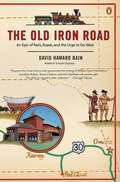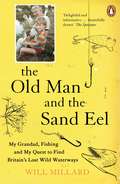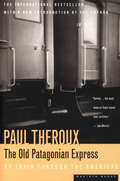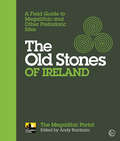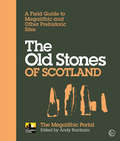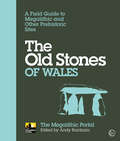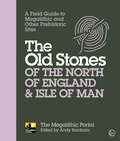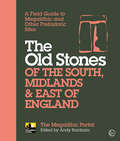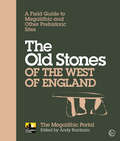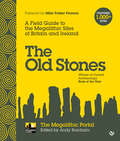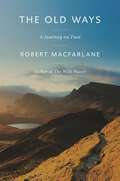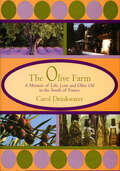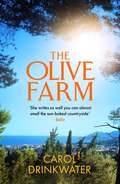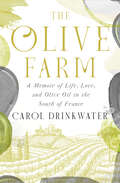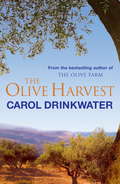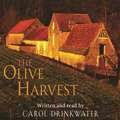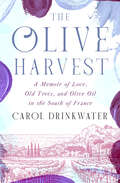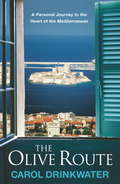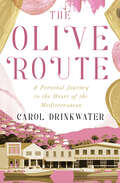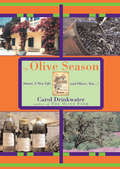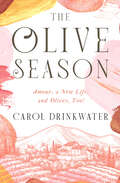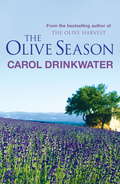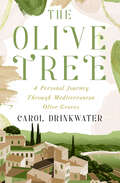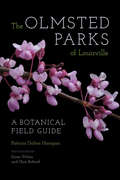- Table View
- List View
The Old Iron Road: An Epic of Rails, Roads, and the Urge to Go West
by David Haward BainThe past called to Bain, also the author of "Empire Express: Building the First Transcontinental Railroad", through his grandmother, born in a covered wagon somewhere in Kansas in 1889. He took his family on a summer-long exploration of the West, tracing portions of emigrant routes between the Missouri River and the Golden Gate -- parts of the Oregon, California, Mormon Pioneer, and Overland Trails; the Pony Express; and the railroad. It was a trip, he told his children, about the journey and not the destination; his account draws an impressionistic narrative line from the Indians, trapper, traders, explorers, engineers, and emigrants 'to those who actually found what they were looking for and settled into the tiny, isolated pioneer communities that grew up, spread out, and transformed the West, confiscating one kind of life and implanting another'.
The Old Man and the Sand Eel
by Will Millard'A wonderfully fluent account of how the strange magic of water and the beings that inhabit it can enchant and intoxicate' Chris YatesGrowing up on the Cambridgeshire Fens, Will Millard never felt more at home than when he was out with his granddad on the riverbank, whiling away the day catching fish. As he grew older his competitive urge to catch more and bigger fish led him away from that natural connection between him, his grandfather and the rivers of his home. That is, until the fateful day he let a record-breaking sand eel slip through his fingers and he knew that he had lost the magic of those days down by the river, and that something had to change. The Old Man and the Sand Eel is at its heart the story of three generations of men trying to figure out what it is to be a man, a father and a fisherman. It plots Will's scaly stepping stones back to his childhood innocence, when anything was possible and the wild was everywhere.***'[Will Millard] is a master wordsmith and his first book is a joyful testament to that' Isabelle Broom, Heat'[Will Millard] writes with a genuine sense of humility (...) humour and reflection' Kevin Parr, Countryfile 'Delightful and informative (...) beautifully drawn (...)The Old Man and The Sand Eel will be enjoyed by anyone who loves the challenge and mystery of baiting a hook and plopping it into the water' Spectator'This is post-modern nature writing that embraces beauty where it finds it and marvels at nature's tenacity (...) But there's more here than just fish. This is also a book about growing up, about how to retain a connection with those who raised you while forging your own identity - what to keep and what to discard. And it's about men. The strong surges of emotion that both draw them together and keep them apart, and the shared pastimes which recognise that intimacy and meaning aren't always accompanied by words' Olivia Edward, Geographical
The Old Patagonian Express: By Train Through the Americas (Penguin Modern Classics Ser.)
by Paul TherouxThe acclaimed travel writer journeys by train across the Americas from Boston to Patagonia in this international bestselling travel memoir.Starting with a rush-hour subway ride to South Station in Boston to catch the Lake Shore Limited to Chicago, Paul Theroux takes a grand railway adventure first across the United States and then south through Mexico, Central America, and across the Andes until he winds up on the meandering Old Patagonian Express steam engine. His epic commute finally comes to a halt in a desolate land of cracked hills and thorn bushes that reaches toward Antarctica. Along the way, Theroux demonstrates how train travel can reveal &“"the social miseries and scenic splendors&” of a continent. And through his perceptive prose we learn that what matters most are the people he meets along the way, including the monologuing Mr. Thornberry in Costa Rica, the bogus priest of Cali, and the blind Jorge Luis Borges, who delights in having Theroux read Robert Louis Stevenson to him.
The Old Stones of Ireland: A Field Guide to Megalithic and Other Prehistoric Sites
by Andy BurnhamThis ebook covers both the Republic of Ireland and Northern Ireland. It could easily have been filled with sites from the Republic’s southwest alone, the counties of Cork and Kerry being famed for their wedge tombs and their stone circles (often in absolutely beautiful locations) that include Drombeg, Derreenataggart, Ardgroom, Shronebirrane, Uragh and many others. Otherwise, visitors tend to head for the cluster of sites around Newgrange (Co. Meath) to the east. That there were once even more prehistoric monuments in this rich farmland was revealed in the sweltering summer of 2018, when the parched earth showed up previously undetected sites as cropmarks. Also included in this ebook are many lesser-known but wonderful sites from the north and east of Ireland, such as the vast megalithic complexes of Beaghmore, Carrowmore and Carrowkeel. Each of these will take a whole day to explore fully, so allow plenty of time. The Old Stones of Ireland is part of a series covering the megalithic and other prehistoric sites of Britain and Ireland. The series is published together as The Old Stones: A Field Guide to the Megalithic Sites of Britain and Ireland, available as a book and an ebook.
The Old Stones of Scotland: A Field Guide to Megalithic and Other Prehistoric Sites
by Andy BurnhamWhere to start with Scotland? From what amounts to a stone circle showroom at Machrie Moor on Arran in the southwest, up to Orkney in the far north where some of Britain’s most spectacular prehistoric remains can be found, there are amazing sites of all types up and down the country. Some settings are unexpected – Balfarg, one of Scotland’s largest henge monuments – is situated in the centre of a 1980s housing estate in Fife, while the stone circle of Craighead Badentoy in Aberdeenshire is surrounded by huge industrial containers. If you don't have long, then the Isle of Arran or Kilmartin Valley (Argyll) are good choices, as both are reachable in a day from Glasgow and contain a wealth of prehistoric monuments. If you have longer, then consider visiting Orkney or Western Isles such as Lewis and Harris for world-famous sites as well as hundreds of lesser-known treasures. The Old Stones of Scotland is part of a series covering the megalithic and other prehistoric sites of Britain and Ireland. The series is published together as The Old Stones: A Field Guide to the Megalithic Sites of Britain and Ireland, available as a book and an ebook.
The Old Stones of Wales: A Field Guide to Megalithic and Other Prehistoric Sites
by Andy BurnhamThere are many hundreds of fascinating prehistoric sites in Wales, in some of the most beautiful locations in Britain, from mountaintop settings, such as at Bryn Cader Faner, to headlands with all-round sea views, as at Coetan Arthur, or on truly remote moorland, as at Bannau Sir Gaer. The road links between North and South Wales are not that great, so it's probably best to choose one or the other as a destination unless you are up for a lot of motoring. In North Wales, Anglesey has a particularly dense concentration of megalithic sites, with many in Gwynedd and Conwy to visit on the way. South Wales stretches from Monmouthshire to Pembrokeshire, where there is the biggest and best variety of sites, including the iconic Pentre Ifan with its capstone apparently delicately floating over its three massive uprights. The Old Stones of Wales is part of a series covering the megalithic and other prehistoric sites of Britain and Ireland. The series is published together as The Old Stones: A Field Guide to the Megalithic Sites of Britain and Ireland, available as a book and an ebook.
The Old Stones of the North of England & Isle of Man: A Field Guide to Megalithic and Other Prehistoric Sites
by Andy BurnhamThis ebook covers Neolithic and Bronze Age places in Lancashire, Yorkshire, Cumbria and Northumberland, as well as on the Isle of Man. The northern English sites split into two main groups: there are the famous stone circles of Cumbria and the Lake District to the west, and the less well-known but equally inspiring rock art of Northumberland near the east coast. But that's not all – there is also a multitude of rock art, megalithic and earthen sites across Yorkshire, with some hugely impressive standing stones that include our tallest at Rudston, and some magnificent henges, such as the rare triple henge of Thornborough. The Old Stones of the North of England & Isle of Man is part of a series covering the megalithic and other prehistoric sites of Britain and Ireland. The series is published together as The Old Stones: A Field Guide to the Megalithic Sites of Britain and Ireland, available as a book and an ebook.
The Old Stones of the South, Midlands & East of England: A Field Guide to Megalithic and Other Prehistoric Sites
by Andy BurnhamThis ebook covers the Neolithic and Bronze Age remains of southern and central England, from Wiltshire to the west and Derbyshire in the north, over to Kent and Essex in the east – yes, there are megalithic sites in Essex … read on to find out where! Wiltshire needs no introduction, but don’t forget the lesser-known sites there such as Merlin's Mound, which was recently confirmed as a prehistoric sibling to Silbury Hill. Unlike most books on megalithic sites, we haven't overlooked the southeast of England, where there are an unexpected number of beautiful long and round barrows, including one with its own protected view of St Paul's Cathedral. And if you want your fill of megalithic sites, there is no need to travel any further afield than Derbyshire, where there are many lovely sites to visit, from the massive henge of Arbor Low to the charming little woodland circle of Doll Tor to the fascinating complex of Barbrook, with one of the Peak District’s best-preserved stone circles. The Old Stones of the South, Midlands & East of England is part of a series covering the megalithic and other prehistoric sites of Britain and Ireland. The series is published together as The Old Stones: A Field Guide to the Megalithic Sites of Britain and Ireland, available as a book and an ebook.
The Old Stones of the West of England: A Field Guide to Megalithic and Other Prehistoric Sites
by Andy BurnhamThis ebook covers the Neolithic and Bronze Age remains of Cornwall, Devon, Somerset, Gloucestershire and Dorset. If you’re looking to visit as many iconic megalithic sites in as short a time as possible, then West Penwith, at the very tip of Cornwall, should be high on your list, with its famous holed stone at Mên-an-Tol, the leaning pillar inside the circle of Boscawen-ûn, and much else. But there are many other treasures to find throughout the region. Dartmoor is famous for its stone rows (around 86 of these have been identified), and Exmoor for the challenge of its hard-to-spot “minilithic” settings. Britain’s second-largest stone circle is at Stanton Drew in Somerset, while the 10km (6 mile) long Dorest Cursus is probably Britain’s largest Neolithic site. If you’re visiting Gloucestershire, you may also want to download The Old Stones of Wales ebook as the sites here are very close to South Wales. The Old Stones of the West of England is part of a series covering the megalithic and other prehistoric sites of Britain and Ireland. The series is published together as The Old Stones: A Field Guide to the Megalithic Sites of Britain and Ireland, available as a book and an ebook.
The Old Stones: A Field Guide to the Megalithic Sites of Britain and Ireland
by Andy Burnham“A wonderful guide to the many megaliths of Britain’s Neolithic and Bronze Age.” --Mike Parker Pearson, Professor of British Later Prehistory at UCL This is the most comprehensive and thought-provoking field guide ever published to the iconic standing stones and prehistoric places of Britain and Ireland. The ultimate insiders’ guide, it gives unparalleled insight into where to find prehistoric sites and how to understand them, by drawing on the knowledge, expertise and passion of the archaeologists, theorists, photographers and stones aficionados who contribute to the world’s biggest megalithic website – the Megalithic Portal. Including over 30 maps and site plans and hundreds of colour photographs, it also contains scores of articles by a wide range of contributors, from archaeologists and archaeoastronomers to dowsers and geomancers, that will change the way you see these amazing survivals from our distant past. Locate over 1,000 of Britain and Ireland’s most atmospheric prehistoric places, from recently discovered moorland circles to standing stones hidden in housing estates. Discover which sites could align with celestial bodies or horizon landmarks. Explore acoustic, colour and shadow theory to get inside the minds of the Neolithic and Bronze Age people who created these extraordinary places. Find out which sites have the most spectacular views, which are the best for getting away from it all and which have been immortalized in music. And don't forget to visit the Megalithic Portal website and get involved by posting your discoveries online.Contributors include: Vicki Cummings | Robert Hensey | Joshua Pollard | Kenneth Brophy | Anne Teather | Barney Harris | John Barnatt | Adam Welfare | Kirsty Millican | Terence Meaden | Gail Higginbottom | Liz Henty | Sandy Gerrard | Ian McNeil Cooke | Penelope Foreman and many others All royalties from this book go to support the running of the Megalithic Portal: www.megalithic.com
The Old Ways
by Robert MacfarlaneFrom the acclaimed author of The Wild Places, an exploration of walking and thinkingIn this exquisitely written book, Robert Macfarlane sets off from his Cambridge, England, home to follow the ancient tracks, holloways, drove roads, and sea paths that crisscross both the British landscape and its waters and territories beyond. The result is an immersive, enthralling exploration of the ghosts and voices that haunt old paths, of the stories our tracks keep and tell, and of pilgrimage and ritual.Told in Macfarlane's distinctive voice, The Old Ways folds together natural history, cartography, geology, archaeology and literature. His walks take him from the chalk downs of England to the bird islands of the Scottish northwest, from Palestine to the sacred landscapes of Spain and the Himalayas. Along the way he crosses paths with walkers of many kinds--wanderers, pilgrims, guides, and artists. Above all this is a book about walking as a journey inward and the subtle ways we are shaped by the landscapes through which we move. Macfarlane discovers that paths offer not just a means of traversing space, but of feeling, knowing, and thinking.
The Olive Farm: A Memoir of Life, Love and Olive Oil in South of France
by Carol Drinkwater"All my life, I have dreamed of acquiring a crumbling, shabby-chic house overlooking the sea. In my mind's eye, I have pictured a corner of paradise where friends can gather to swim, relax, debate, eat fresh fruits picked directly from the garden and great steaming plates of food served from an al fresco kitchen and dished up on to a candlelit table the length of a railway sleeper. . . " When Carol Drinkwater and her partner Michel have the opportunity to buy 10 acres of disused olive farm in Provence, the idea seems absurd. After all, they don't have a lot of money, and they've only been together a little while. THE OLIVE FARM is the story of the highs and lows of purchasing the farm and life in Provence: the local customs and cuisine; the threats of fire and adoption of a menagerie of animals; the potential financial ruin and the thrill of harvesting their own olives - especially when they are discovered to produce the finest extra-virgin olive oil. . .
The Olive Farm: A Memoir of Life, Love and Olive Oil in the South of France
by Carol DrinkwaterThe first in Carol Drinkwater's bestselling trilogy set on a Provencal olive farm.'She writes so well you can almost smell the sun-baked countryside' BELLA'Spellbinding' CHOICE'Vibrant, intoxicating and heart-warming' SUNDAY EXPRESS'All my life, I have dreamed of acquiring a crumbling, shabby-chic house overlooking the sea. In my mind's eye, I have pictured a corner of paradise where friends can gather to swim, relax, debate, eat fresh fruits picked directly from the garden and great steaming plates of food served from an al fresco kitchen and dished up on to a candlelit table the length of a railway sleeper...'When Carol Drinkwater and her partner Michel have the opportunity to buy 10 acres of disused olive farm in Provence, the idea seems absurd. After all, they don't have a lot of money, and they've only been together a little while. THE OLIVE FARM is the story of the highs and lows of purchasing the farm and life in Provence: the local customs and cuisine; the threats of fire and adoption of a menagerie of animals; the potential financial ruin and the thrill of harvesting their own olives - especially when they are discovered to produce the finest extra-virgin olive oil...
The Olive Farm: A Memoir of Life, Love, and Olive Oil in the South of France (The Olive Farm Series)
by Carol DrinkwaterThis memoir of buying and transforming an abandoned olive farm &“describes life in the South of France with lush, voluptuous appreciation&” (Publishers Weekly). Presented with an opportunity to purchase a ten-acre property near Cannes, actress Carol Drinkwater and her film-producer fiancé, Michel, decide to take the plunge. It will take all their savings just for the down payment, but the beauty of the surrounding countryside and the promise of a new adventure seem worth the risk. As they work to clear the weeds and rehabilitate the abandoned farm, they meet Provence&’s quirky locals, puzzle through France&’s legal bureaucracy, explore the nearby Mediterranean islands, and encounter the region&’s wildlife. This colorful memoir from the Sunday Times–bestselling author recounts one couple&’s remarkable journey from being inspired but inexperienced new landowners to realizing their dream of a fulfilling, peaceful life on their own little plot of paradise. &“Good-humored and well-written.&” —The Washington Post &“A fantasy come true, as it will be for many of the readers who yearn to experience the magic of southern France.&” —The Austin Chronicle
The Olive Harvest: A Memoir of Love, Old Trees, and Olive Oil
by Carol DrinkwaterThe third episode of a bestselling story which began with THE OLIVE FARM - now in a gorgeous new look."The stars shimmer like spilled handfuls of glitter. The day is beginning to rise with a faint mist. As I turn my head, ghostly halos, auras of light, appear and disappear ... The silence is truly awesome. Not a bird, not a whisper of wind, not a breath of life. Only the two of us, a most implausible pair, standing shoulder to shoulder gazing upon an awakening heaven"Returning to their home after an extended absence Carol and her husband Michel are looking forward to summer together on the farm. A shocking blow leaves Carol alone and the future is uncertain. Feeling isolated and with no olives to harvest, Carol ventures beyond the farm to explore other aspects of Provencal life - from hunting to bee-keeping, the ancient language to the ever-present demands of family and friends. And ultimately, Provence's generous diversity - and Carol's own persistence in sharing it with those she loves - paves a path to joy.
The Olive Harvest: A Memoir of Love, Old Trees, and Olive Oil
by Carol DrinkwaterThe third episode of a bestselling story which began with THE OLIVE FARM - now in a gorgeous new look."The stars shimmer like spilled handfuls of glitter. The day is beginning to rise with a faint mist. As I turn my head, ghostly halos, auras of light, appear and disappear ... The silence is truly awesome. Not a bird, not a whisper of wind, not a breath of life. Only the two of us, a most implausible pair, standing shoulder to shoulder gazing upon an awakening heaven"Returning to their home after an extended absence Carol and her husband Michel are looking forward to summer together on the farm. A shocking blow leaves Carol alone and the future is uncertain. Feeling isolated and with no olives to harvest, Carol ventures beyond the farm to explore other aspects of Provencal life - from hunting to bee-keeping, the ancient language to the ever-present demands of family and friends. And ultimately, Provence's generous diversity - and Carol's own persistence in sharing it with those she loves - paves a path to joy.
The Olive Harvest: A Memoir of Love, Old Trees, and Olive Oil
by Carol DrinkwaterIt is April, late spring. Here in the hills behind the Cote d'Azur, the olive groves are delicately blossomed with their tiny white-forked flowers. Beyond them, perched halfway up the slope of the hill, our belle epoque villa comes into view...'Returning to their home after an extended absence Carol and her husband Michel are looking forward to summer together on the farm. A shocking blow leaves Carol alone. The future is uncertain. The Olive Harvest takes us beyond the perimeters of her olive groves to where hunters, poets, bee-keepers, boars and gypsies abide. In search of the language of troubadours, the dark and sometimes barbarous heart of Provence is revealed. Nature and the generosity of the South of France's harvests offer a path to joy and an abundant resolution.(p) 2004 Orion Publishing Group
The Olive Harvest: A Memoir of Love, Old Trees, and Olive Oil in the South of France (The Olive Farm Series)
by Carol DrinkwaterThe story of life on a French olive farm continues with this moving memoir of hard work, hard luck, and waiting for the return of happiness. Carol Drinkwater and her husband, Michel, arrive at their villa in Provence in anticipation of another glorious summer. Unfortunately, they find the farm unkempt and suffering from lack of rainfall. When their gardener, Monsieur Quashia, finally shows up, he cheerfully explains the shed-building project he&’s working on as a surprise for them—a surprise that will send their expenses skyrocketing. But there are bigger problems to come than wild boars tearing through fences and other everyday challenges of farming. After a terrifying accident in Monte Carlo and a hospital stay, Michel is barely functional, and Carol soon realizes she must fend for herself. Burdened with problems from a financial reversal to the threat of nearby wildfires, she will experience firsthand the uncertainties that have plagued farmers since the dawn of agriculture—and hold on to hope that in the end, nature will provide. &“A storyteller of great economy and deftness.&” —The Telegraph
The Olive Route: A Personal Journey to the Heart of the Mediterranean
by Carol DrinkwaterIn the terrific bestselling olive series by writer and actress Carol Drinkwater, bestselling author of THE FORGOTTEN SUMMER'She writes so well you can almost smell the sun-baked countryside' BELLA'Spellbinding' CHOICE'One cannot resist Drinkwater's courage and joie de vivre, nor the enormous appetite and enthusiasm for her subject' Wendy Holden DAILY MAILSince Carol Drinkwater moved to an olive farm in France she has developed a passion for the olive tree and the culture that has grown up around it. From the eastern shores of the shimmering Mediterranean to its western coast this fruit is farmed. Its silvery-green branches have inspired painters and poets, but who first pressed its 'bitter berry' and transformed it into liquid gold?In quest of its secrets and traditions, Carol embarked on a solo adventure round the Mediterranean basin. Transporting readers across the olive's ancient paths, celebrating its venerable past, tracking trade routes, unearthing unlikely stories, encountering peoples of today and bygone times, Carol comes full circle, back to her farm in the sun-baked Provençal hills.
The Olive Route: A Personal Journey to the Heart of the Mediterranean (The Olive Farm Series)
by Carol DrinkwaterThe author of acclaimed memoirs about life on a French olive farm explores the larger history and culture of the Mediterranean delicacy. Carol Drinkwater has a passion for olive trees and the fruit they bear—&“bitter berries&” that are transformed into savory delights and pressed into precious oil. Already intimately familiar with the fruit thanks to her olive farm in the South of France, she decided to travel throughout the Mediterranean basin—from Marseille to Malta, Israel to Tunisia—in a quest to learn about their ancient history, their spread throughout the world, and the tastes and traditions they represent. A culinary travelogue and a celebration of a humble, healthful food that inspires devotion among so many, The Olive Route is filled with unusual characters and fascinating anecdotes from &“a storyteller of great economy and deftness&” (The Telegraph). &“Drinkwater has a sharp eye for character, and the people who populate The Olive Route will not disappoint her fans.&” —The Independent
The Olive Season
by Carol DrinkwaterIn The Olive Season, Carol Drinkwater’s much-anticipated follow-up to The Olive Farm, Carol and Michel prepare to exchange vows in, of all places, Polynesia—Michel's answer to Carol's challenging response to his marriage proposal (Only if the ceremony is Upon their return to the south of France as husband and wife, they find there is much hope—and work—to greet them. With a farm consisting of fifty trees producing some of the world’s finest olive oil, no longer is the challenge one of restoring the farm but in charting its development and growth. France’s rigorous agricultural standards are responsible for some of the world's best produce but also for one of its most infuriating bureaucracies. In order to obtain the coveted AOC rating, Carol and Michel are forced to both expand their farm and to negotiate a Byzantine world of forms, officials, and inspections, including the surveying of their land by a water diviner, who, via a power akin to extrasensory perception, can point out the existence of underground water sources on their property. Further complicating matters is the fact that Carol has become pregnant with the couple’s first child and has just accepted a demanding acting role. As the harvest season approaches, dramatic events, culminating in a heartbreaking miscarriage, cast shadows over the olive farm. With all the warmth and vibrancy of the Mediterranean sun, Carol Drinkwater tells her passionate, moving, and utterly uplifting story.
The Olive Season: Amour, a New Life, and Olives, Too! (The Olive Farm Series)
by Carol Drinkwater&“A lovely balance of memoir, travelogue and olive-growing how-to . . . Some of her adventures are quite funny.&” —Publishers Weekly In this memoir, the author of The Olive Farm returns to the ten-acre property for which she and her fiancé scraped together their savings to buy—just back from their wedding on a tiny Polynesian island, loaded down with luggage and a large hand-painted didgeridoo. As Carol and Michel settle in as husband and wife, they experience the glamor of southern France at dinner parties in the company of aristocrats and at the world-renowned Cannes film festival, as well as the dirt-caked, sun-baked life of farmers—especially after their gardener heads to Algiers to arrange his youngest son&’s wedding. For Carol, though, what matters most is that her longtime dream of motherhood finally promises to come true—and over the course of The Olive Season, she shares the story of her hopes and fears as she anticipates another kind of growth and nurturing. Alternately entertaining and emotionally poignant, this memoir is a rich portrait of love, longing, and the constant uncertainties of the cycle of life.
The Olive Season: By The Author of the Bestselling The Olive Farm
by Carol DrinkwaterSecond in the bestselling Olive Farm story from the bestselling author of THE FORGOTTEN SUMMER'She writes so well you can almost smell the sun-baked countryside' BELLA'Vibrant, intoxicating and heart-warming' SUNDAY EXPRESS'I scan the terraces, planted with row upon row of ancient olive trees. It is April, late spring. Here in the hills behind the Cote d'Azur the olive groves are delicately blossomed, with their tiny, white-forked flowers. Beyond them, perched halfway up the slope of the hill, our belle epoque villa comes into view. Abounding in balustrade terraces, nestling among cedars and palms, facing out at a south-westerly angle, overlooking the bay of Cannes towards the sun-kissed Mediterranean, there it is, Appassionata, awaiting us...'THE OLIVE FARM told how Carol Drinkwater and partner Michel fell in love with and bought an abandoned Provencal olive farm. Now, in THE OLIVE SEASON, Carol is pregnant and their ever-loyal gardener is leaving to oversee the marriage of his son. Often unassisted, and with new challenges to face, Carol takes on the bulk of the farm work alone. Water is, as ever, a costly problem, and she goes in search of a diviner who promises almost magical results. But, as the harvest season approaches, dramatic events cast dark shadows of their olive farm.
The Olive Tree: A Personal Journey Through Mediterranean Olive Groves (The Olive Farm Series)
by Carol DrinkwaterAn olive farmer journeys through Spain, Italy, and North Africa to find the future of agriculture in an age of chemicals and climate challenges. Carol Drinkwater&’s beloved olive farm in the South of France was suffering badly from destructive pests and premature ripening. In a hunt for answers, she decided to set out on her own for a fact-finding tour of Spain, Italy, Morocco, and Algeria. In The Olive Tree, Carol recounts not only the agricultural education she gained during her travels, but the dangers she faced as terrorist bombs rocked one of her destinations and a group of beekeepers helped shepherd her through dangerous territory. Through it all, she confronts issues faced by farmers and non-farmers alike in today&’s world, from climate change to diminishing water reserves to the excessive use of chemicals. Ultimately, she will return to her land in Provence with a new appreciation for the urgency of these problems—and with an ingenious vision for the future shared with her by a brilliant group of olive growers . . .Praise for the Olive Farm series &“Vibrant, intoxicating and heartwarming.&” —Sunday Express &“Spellbinding . . . a must for anyone who dreams of moving to a kinder climate and starting a new life.&” —Choice
The Olmsted Parks of Louisville: A Botanical Field Guide
by Patricia Dalton Haragan“A quality tribute to America’s greatest landscape architect, these parks he created, and especially the plants that thrive there.” —Plant Science BulletinFrederick Law Olmsted, popularly known as the “Father of American Landscape Architecture,” is famous for designing New York City’s Central Park, the US Capitol grounds, and the campuses of institutions such as Stanford University and the University of Chicago. His celebrated projects in Boston, Buffalo, Detroit, Milwaukee, and other cities led to a commission from the city of Louisville, Kentucky, in 1891. There, he partnered with community leaders to design a network of scenic parks, tree-lined parkways, elegant neighborhoods, and beautifully landscaped estate gardens that thousands of visitors still enjoy today.The Olmsted Parks of Louisville is the first authoritative manual on the 380 species of trees, herbaceous plants, shrubs, and vines populating the nearly 1,900 acres that comprise Cherokee, Seneca, Iroquois, Shawnee, and Chickasaw Parks. Designed for easy reference, this handy field guide includes detailed photos and maps as well as ecological and historical information about each park. Patricia Dalton Haragan also includes sections detailing the many species of invasive plants in the parks and discusses the native flora that they displaced.This guide provides a key to Olmsted’s vision, revealing how various plant species were arranged to emphasize the beauty and grandeur of nature. It’s an essential resource for students, nature enthusiasts, and visitors from near and far.
